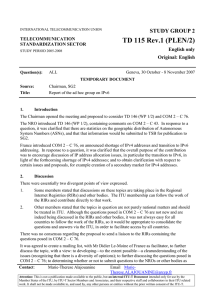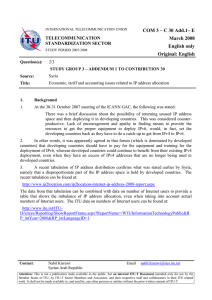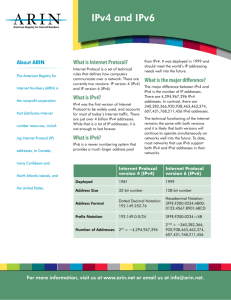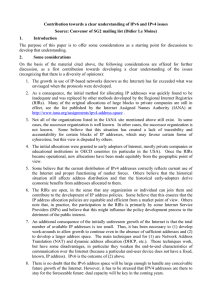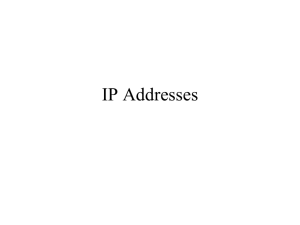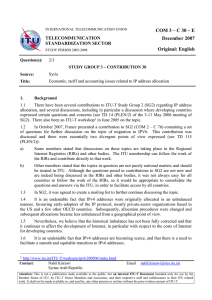COM 2 – C 76 Rev.1 - E October 2007 English only
advertisement
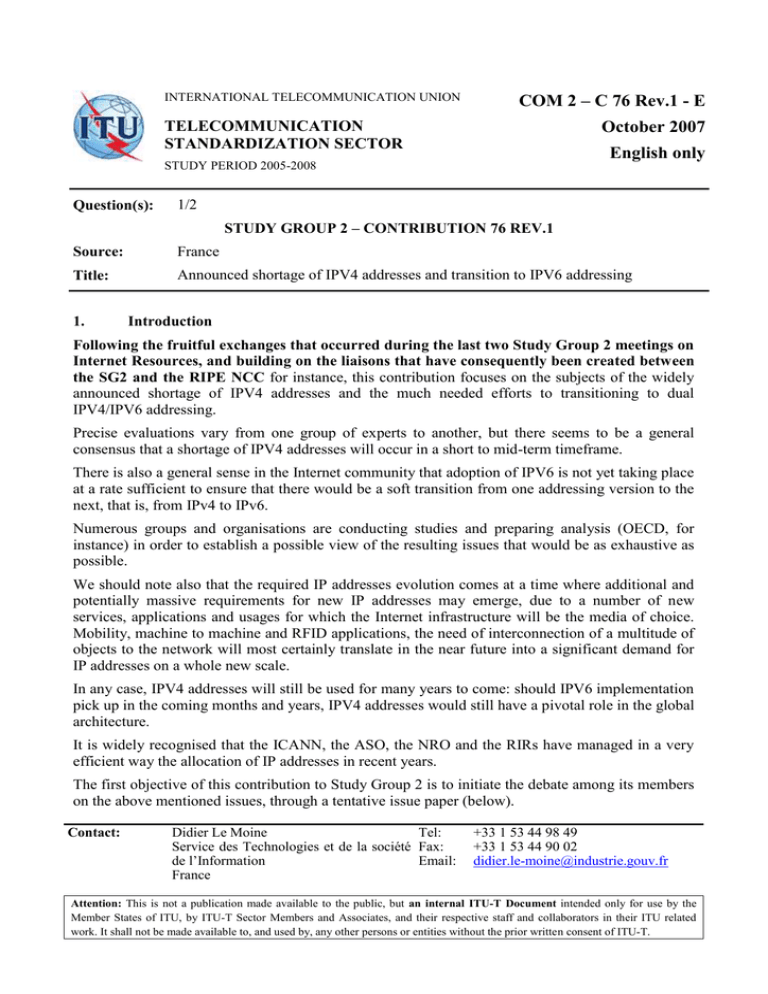
INTERNATIONAL TELECOMMUNICATION UNION COM 2 – C 76 Rev.1 - E TELECOMMUNICATION STANDARDIZATION SECTOR October 2007 English only STUDY PERIOD 2005-2008 Question(s): 1/2 STUDY GROUP 2 – CONTRIBUTION 76 REV.1 Source: France Title: Announced shortage of IPV4 addresses and transition to IPV6 addressing 1. Introduction Following the fruitful exchanges that occurred during the last two Study Group 2 meetings on Internet Resources, and building on the liaisons that have consequently been created between the SG2 and the RIPE NCC for instance, this contribution focuses on the subjects of the widely announced shortage of IPV4 addresses and the much needed efforts to transitioning to dual IPV4/IPV6 addressing. Precise evaluations vary from one group of experts to another, but there seems to be a general consensus that a shortage of IPV4 addresses will occur in a short to mid-term timeframe. There is also a general sense in the Internet community that adoption of IPV6 is not yet taking place at a rate sufficient to ensure that there would be a soft transition from one addressing version to the next, that is, from IPv4 to IPv6. Numerous groups and organisations are conducting studies and preparing analysis (OECD, for instance) in order to establish a possible view of the resulting issues that would be as exhaustive as possible. We should note also that the required IP addresses evolution comes at a time where additional and potentially massive requirements for new IP addresses may emerge, due to a number of new services, applications and usages for which the Internet infrastructure will be the media of choice. Mobility, machine to machine and RFID applications, the need of interconnection of a multitude of objects to the network will most certainly translate in the near future into a significant demand for IP addresses on a whole new scale. In any case, IPV4 addresses will still be used for many years to come: should IPV6 implementation pick up in the coming months and years, IPV4 addresses would still have a pivotal role in the global architecture. It is widely recognised that the ICANN, the ASO, the NRO and the RIRs have managed in a very efficient way the allocation of IP addresses in recent years. The first objective of this contribution to Study Group 2 is to initiate the debate among its members on the above mentioned issues, through a tentative issue paper (below). Contact: Didier Le Moine Tel: Service des Technologies et de la société Fax: de l’Information Email: France +33 1 53 44 98 49 +33 1 53 44 90 02 didier.le-moine@industrie.gouv.fr Attention: This is not a publication made available to the public, but an internal ITU-T Document intended only for use by the Member States of ITU, by ITU-T Sector Members and Associates, and their respective staff and collaborators in their ITU related work. It shall not be made available to, and used by, any other persons or entities without the prior written consent of ITU-T. -2COM 2 – C 76 Rev.1 - E The next paragraph proposes a non-exhaustive tentative list of questions and potential issues related to this topic that could be discussed, amended and completed during this Study Group 2 session. Finally, should Study Group 2 agree upon a list of questions, it could decide to send it to the relevant organizations, notably including, but not limited to, those mentioned above in a spirit of information, experience sharing and awareness raising. This contribution contributes to the implementation of the WSIS outcomes, in particular paragraph 29 of the Tunis Agenda of Tunis (“the international management of the Internet should ensure an equitable distribution of resources, facilitate access for all and ensure a stable and secure functioning of the Internet, taking into account multilingualism”) and follows the adoption of the revised Resolution 102 in Antalya in 2006, and Council Resolution 1282 on ITU’s role in implementing the outcomes of the World Summit on the Information Society. The following paragraphs propose a first categorisation of some of the questions raised as a consequence of the announced shortage of IPV4 addresses and the ramping up of IPV6: 2. Shortage of IPV4 addresses Already allocated IPV4 addresses - What percentage of the IPV4 addresses that each RIR has allocated is actually routed on the public Internet? - What incentives could be put in place in order to make sure that IPV4 addresses allocated by the RIRs are used efficiently, and when they are not any longer used, that they are given back to the global community? - The same two first can be asked regarding IPV4 addresses allocated prior to the existence of the RIRs. Upcoming shortage - What are the predictions of each RIR on their needs for IPV4 addresses for the next years (prevision until 2012)? - What is the anticipated date of shortage, RIRs by RIRs? What policy will be decided by the RIRs to allocate the last IPV4 address blocks? - How do the RIRs intend to address the specific needs for emerging countries for the coming years? Opportunity of a market mechanism It is anticipated (for example by some RIR representatives) that the shortage of IPV4 addresses, combined with the fact that IPV4 addresses needs will continue to increase in the coming years, that there could be a market (whose nature is still to be defined: secondary or whatever) to enable organisations with an excess of IPV4 addresses to sell these excess IPv4 addresses to organisations in need of such resources. - How would this possibility fit with the following NRO position on the status of the IP Addresses (see below)? “IP Address Rights IP addresses are not owned as property. Regional Internet Registries (RIRs) provide them to Local Internet Registries (LIRs), National Internet Registries (NIRs), and Internet Service Providers (ISPs), who in turn provide them to consumers. The Internet community develops technical and operational policies that determine how addresses are provided. ITU-T\COM-T\COM02\C\076E.DOC -3COM 2 – C 76 Rev.1 - E When a consumer no longer requires the use of the IP address space, it is returned to the LIR or ISP. Since IP addresses are not property, they cannot be bought, sold, traded, transferred, attached, or otherwise provided to anyone other than by methods in the community-defined policy.” - What is the view of the RIRs members regarding a possible monetisation of IPV4 addresses? Was there any study or survey carried by the RIRs on that point? - How do the different RIRs and ICANN, ARO, and NRO view and address the possibility of a potential market for IPv4 addresses? - The IPV4 addresses, under the assumption of a shortage, would change in nature: from resources they would become scarce resources. What impact on global public policy might this have and how would the RIRs envision to take into account this new context? There are a number of resources in the technical community that are scarce: how are they managed at an national, regional and international levels, and how could these existing examples help prepare to manage the coming shortage of IPV4 addresses? - What could be the impact on routing in the network if parts of address blocks were to be exchanged between Telcos, ISPs and other LIRs? Would the exchanges only be allowed within a RIR region or between members of different RIRs? What should be the minimum IPV4 address block size allowed for an exchange in order to limit the fragmentation of IP addressing overall and a consequent decrease in quality of service, and potential impact on the security and stability of the Internet? What would be the impact on routing tables, whose continued growth is a matter of concern? - RIPE NCC has expressed its interest in developing and proposing a certification process for IP address blocks that it allocates to end users: is this project a common initiative between all the RIRs? - If RIRs becomes facilitator of an IPV4 addresses secondary market, would it have an effect on their bylaws, status and missions? - As for any market, have the questions of fair competition and assurance that there would be no abuse of a dominant position been assessed by the RIRs? - Should an IPV4 address market emerge, who would manage the corresponding databases (in order for instance to ensure traceability of IP addresses with respect to law enforcement capabilities)? Other approaches - What other scenarios, other than a market, have the RIRs been exploring as a way forward to deal with IPV4 shortage? - Policies that would make it possible to take back the unused/not-routed address blocks and redistribute them to where it is needed? (“use it or lose it” principle?) - Policies to prevent the exchange of IPV4 address blocs on a monetization basis in order to foster all the Internet community to move in the short term and in a simultaneous way to IPV6? - The shortage could be an incentive for organisations to implement NATs to an even greater extent than today: are there any technical studies on the potential impact of using NATs or multilayered NATs on performance, stability, security and continuity of service? ITU-T\COM-T\COM02\C\076E.DOC -4COM 2 – C 76 Rev.1 - E 3. Ramping up of IPV6 addressing The ramping up of IPv6, already partially begun, is an opportunity for establishing a transparent and fair procedure for allocating address blocks, through careful study of the impact on the security and stability of the network. Such a procedure was defined by ASO/NRO/ICANN/RIRs. The IANA function is assumed by ICANN. A bottom-up approach has produced an "Allocation of IPv6 Address Space" process which was adopted by the board of ICANN. Promoting the ramping up of IPV6 For years to come IPV4 and IPV6 will coexist on the network: one of the ways forward seems to reside in dual stacking of V4 and V6. - What kind of public policies, including pioneer adoption by governments in e-government services, could be used to promote dual stack IPV4/IPV6 implementation? - Would there be any possibility to have a corresponding unique IPV6 address for each IPV4 address? Would that help? - Are the ICANN/ASO/NRO/RIRs preparing an information kit regarding IPV6 implementation as an awareness raising tool? When would it be available? - What is, for each RIR, the regional IPV6 allocation policy? - What are the plans to conduct educational activities on transition to IPV6 by ICAN/ASO/NRO/RIRs? - Which specific activities should be undertaken by ITU-T and ITU-D in order to promote awareness and to provide support towards this transition, in accordance with Plenipotentiary Resolution 102 (Antalya) and Council Resolution 1282? - How to guarantee that developing countries get a fair treatment? Should there be a specific approach for them regarding IPV6? 4. Conclusion As mentioned in the introduction, the first objective of this contribution to Study Group 2 is to initiate the debate among its members on the above mentioned issues. The proposed list of questions and potential issues related to the topics of the coming shortage of IPV4 addresses and the transition to IPV6 could be one of the starting points of exchanges within the Study Group 2 on these important matters. The Study Group 2 could start amending and completing this list during this session. Should Study Group 2 agree upon a list of questions, it could decide to send some of the questions to the relevant organizations, including the ones with which a liaison was initiated during the last SG2 sessions. (vf) _______________ ITU-T\COM-T\COM02\C\076E.DOC
